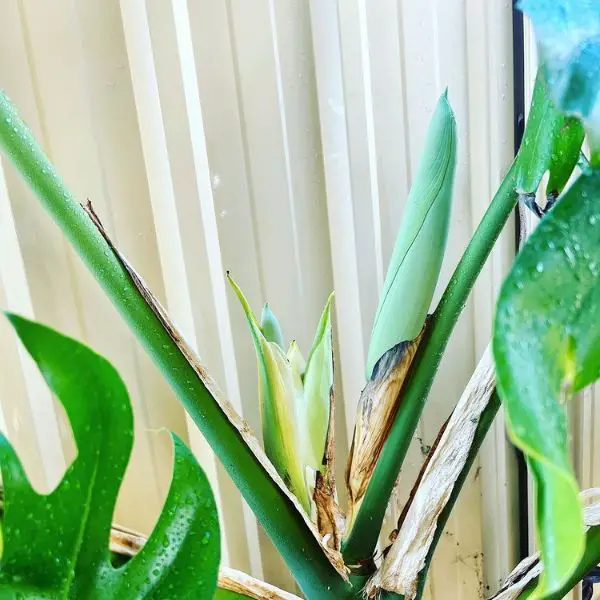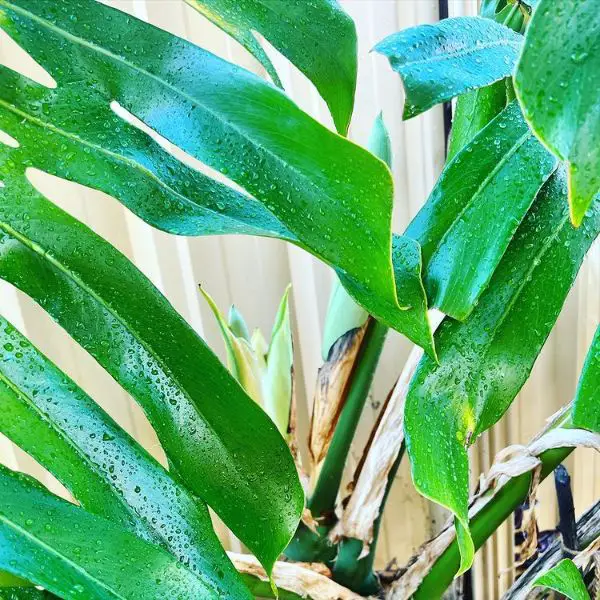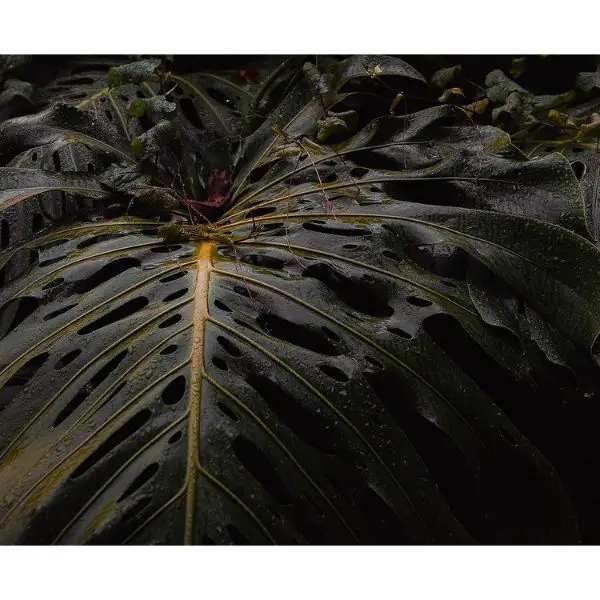With their large, vibrant leaves and stunning tropical beauty, Monstera has captured the hearts of gardeners worldwide. These iconic houseplants, also known as Swiss cheese plants, are known for being relatively easy to care for.
However, when it comes to their ideal growing conditions, one question often arises: What is the optimal humidity for Monstera? Join me to explore science to nurture these trees.
In This Article
Do Swiss Cheese Plants Like Humidity?
Yes, Monstera loves humidity. It is a common tropical plant in South and Central America. Its preferred habitat thrives in moderate to high humidity ranging from 60% to 80%. While these plants still develop in indoor conditions with lower levels than tropical forests, prioritize humidity to foster the thriving of your Monsteras and address any signs of stress.

So, how exactly does humidity influence Monstera? During photosynthesis, it requires moisture to facilitate the opening of its stomata (small holes on the Monstera leaves). A consistent water supply maintains hydration levels, and transpiration prevents excessive water loss.
Humidity also plays a significant role in its health. Sufficient moisture in the air nourishes and supports the lush, vibrant foliage. A balanced humidity level ensures plants can absorb essential nutrients during their growth. This promotes robust growth, stronger root development, and overall plant vitality.
Last but not least, high humidity acts as a natural deterrent for harmful insects and pests. A high moisture level hinders their reproduction, limiting their impact on Swiss cheese plants. Maintaining a humid atmosphere surrounding your plants can protect them from infestations and enhance their resistance to pests.
How Much Humidity Do Monsteras Plants Need?
In The Wild
Monsteras in the wild grow under the shelter of larger trees, benefiting from indirect light and stable temperature and humidity all year round. They develop large leaves that absorb moisture from the air and aerial roots that seek out nearby water sources.
Biologists have observed that these plants thrive under natural humidity levels of 60%-80% and temperatures of 65° to 90° F. Under these ideal conditions, some well-established specimens expand to an impressive 70 feet long and produce foliage up to 3 feet in width.
Indoors
While mimicking their wild habitat indoors is challenging, it’s still possible to create a suitable environment for the health and happiness of Swiss cheese plants. One crucial aspect is to maintain a moist and warm atmosphere.
Place your ornamentals in an area with strong, indirect natural light. This ensures they receive the necessary energy while avoiding leaf burn. Additionally, it is essential to maintain temperatures within the ideal range during the day and slightly lower at night.
The most critical factor to consider is humidity. Keep the indoor moisture at around 50% to 60%. Or else, your plants may suffer from dryness, stress, and wilting.
How Do I Know If My Monstera Needs More Humidity?
When your plant absorbs enough moisture, it will display an upright posture and dark green leaves with a soft surface. Meanwhile, lack of water or heat stress can harm its overall health. As soon as you notice the visible signs below, take action:
- Rough and dry leaf leaves
- Brown spots on the edges and tips of the leaves, and occasionally, between the veins.
- Yellow leaves
- Drooping, curling, or rolling foliage
- Withering and leaf loss
- Stunted or slow growth
How To Measure Monstera Humidity
Ice Cube Testing
This method does not give you an exact reading but a rough idea whether your space is damp or dry. The entire process is effortless with a few simple steps:
- Prepare a glass cup and 4-5 ice cubes.
- Put the ice cubes in the cup and place it in the living area of your Monstera.
- Leave it there for about five to ten minutes and check it afterward. If you notice numerous water droplets forming on the surface of the glass, it indicates a high humidity rate and vice versa.
Hygrometer Testing
A hygrometer can come in handy, performing comprehensive monitoring whenever you need it. I recommend opting for a device with a temperature measurement function since both factors play an important role in plant growth. Instructions are included with each tool, but the basic measuring process consists of the following steps:
- Activate the hygrometer and allow the tool to calibrate itself.
- Wait for a few minutes until the results show up. However, repeat this operation every 1-2 hours to observe variations throughout the day.
There are two common designs: handheld or wall-mounted moisture meters. While both options have their merits, I myself favor the second option.
I attached it to a central location on the wall to cover the entire room. That said, this choice is only suitable for small spaces. If you grow Monstera in a spacious room, purchase a handheld hygrometer.
How To Increase Humidity For Monsteras
Group Monstera With Other Plants
Grow your Monstera with other companion plants to create a microclimate with higher humidity. Plants release moisture through a process called transpiration when grouped. Just make sure they have enough space and light to grow.
Utilize A Pebble Tray
Place a tray or saucer filled with water and pebbles beneath your pot. As the water evaporates, it increases the humidity near the plant. Adjust the water level below the top surface of the pebbles to avoid root rots.
It’s like “set it and forget it,” so I usually apply this trick whenever I have to leave home for a few days or don’t have time to care for my lovely plants.
Install Humidifier
For a hands-free care routine, there is nothing better than installing a humidifier. This tool offers convenient control over the timing, frequency, and misting strength throughout the day while limiting the heat generation that may promote mold growth.
I usually set the humidifier to turn on automatically every hour but have to fill the water tank every two days. So, keep an eye on the water level and refill as needed.
Hide Monstera From Direct Sun
While sunlight is crucial for plant growth, you should know the right amount. Place the Swiss cheese plant near a large window during winter but avoid direct sunlight in hot summer months, as it will cause the leaves to dry out.
I conducted a series of tests by placing the Monstera pot at different spots in my house. After careful observation, I discovered the perfect “home” for our plant – on a desk about 5 feet from the small window in the living room. The sunlight filtering through the thin curtain is enough to nourish the Monstera without harming them.
Put Your Plant In High-Humidity Rooms
Bathrooms, kitchens, and laundry rooms have the highest humidity levels, somewhat mimicking the tropical environment for Monsteras.
Be mindful of providing adequate light and avoiding extreme temperature changes. For instance, you should not arrange plants near a stove or any heat sources but on a kitchen island instead.
Use Boiling Water
This trick is what I usually apply during winter. I heat a pot of water until it boils. In a short time, a stream of humidity will fill the room and nourish your house plants. Using a crock pot or a radiator is best to prolong the evaporation process.
Use A Peat Moss Potting Mix
Soil amendments are a sustainable solution for boosting indoor humidity. In this case, peat moss, created from decomposing plants, should come out on top. This type of soil not only adds moisture but also beneficial organic compounds for Monstera.
Another plus point is that it improves drainage through aeration. You can easily find this ingredient at local plant stores or online commercial platforms.
Cover Your Plant With A Plastic Bag
Creating an indoor greenhouse environment is a great idea to raise the humidity level, and bunching a clear plastic bag on top of the Swiss cheese is the quickest and simplest way. I often take advantage of this tip when temperatures drop significantly in the winter.
However, I’ve made a few mistakes before learning to do it correctly. And here is my lesson: prepare a large bag to create a comfortable growing space for the leaves, and never tie the bag tightly.
Mist Your Plant
This solution brings immediate results to save your Monstera. Investing in a mist sprayer does not cost much but can maintain an adequate humidity level for your plants.
Set the mist output at a moderate level to avoid damaging the foliage. If you’re caring for many plants at once, an automatic misting system is a worthwhile investment.
Other Tips
There are a few additional steps to ensure an optimal humidity level:
- Check the soil moisture and make sure it is between 70-85%.
- Monitor your house humidity throughout the year, especially in winter when air inside is drier.
- Pay attention to how your Monstera reacts to its surroundings and the humidity adjustments you’ve made.
How Often Should I Mist My Monsteras?

The misting frequency varies depending on your plant’s condition and the current humidity level. On days with low humidity, you can mist your Monstera 2-3 times a day. If the air feels moist, adjust the frequency to once a day or 2-3 times a week.
To determine the appropriate frequency for your plant, assess the moisture level by touching the foliage. Dry and brittle leaves are calling out for increased misting, while healthy, lush, and dark green leaves mean you can extend the interval.
FAQs
Are There Any Symptoms That My Monsteras Plant Is Getting Too Much Humidity?
Excess water can kill your plants, so pay attention to the following common signs:
- Damp leaves
- Mold or fungal diseases on foliage or in the potting mix
- Root rot
- Pest infestations
- Soft stem

What Factors To Consider When Choosing A Humidifier For My Monsteras?
Several factors should be considered to ensure a humidifier meets your needs, including humidification capacity and level, mist output, extra functions, noise level, safety features, etc.
What Is The Difference Between Misting And Using A Humidifier?
Misting is a targeted approach, sending moisture directly to the leaves to provide a temporary boost in humidity, which works well for a small number of Monstera pots. In contrast, a humidifier covers a larger area and maintains consistent humidity throughout the room.
Conclusion
Monsteras indeed have humidity requirements, owing to their origins in tropical rainforests. It is essential to monitor the average household humidity and ensure proper ventilation and air circulation. Mimicking the plant’s natural habitat can promote optimal growth and foliage health.
Related Post: Monstera sunburn Signs & How to Fix Burnt Monstera Leaves


